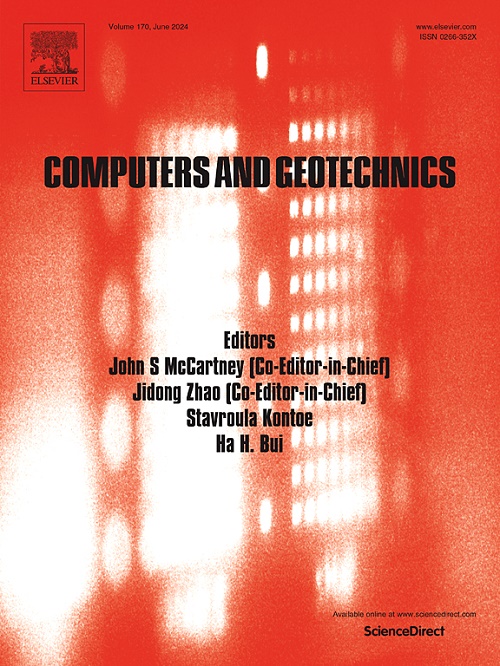Real-time slope stability quantification: Emergent framework coupling landslide displacement with damage mechanics and renormalization group theory
IF 6.2
1区 工程技术
Q1 COMPUTER SCIENCE, INTERDISCIPLINARY APPLICATIONS
引用次数: 0
Abstract
Empirical observations have revealed the dynamic evolution of slope stability with landslide displacement, yet existing methods lack a rigorous mechanical framework to characterize this time-dependent process. To address the theoretical limitations of conventional early warning systems that depend on kinematic parameters (e.g., velocity and acceleration), this study develops a multiscale modeling framework integrating damage mechanics and renormalization group theory. We propose a shear constitutive model incorporating progressive rock damage and establish critical state criteria through renormalization group theory, deriving a displacement-coupled dynamic safety factor equation. Validation via field data from a slope engineering project and the finite difference method (FDM) simulations demonstrates two critical advancements: (1) The non-uniformity of overburden normal stress across the slip surface leads to spatially varying shear constitutive curves in different regions; (2) Slope stability displays nonlinear evolutionary phases (elastic–plastic transition → accelerated degradation → residual state) directly linked to displacement progression. This framework pioneers a physics-based mapping between displacement monitoring and slope stability states, establishing mechanistic foundations for intelligent early landslide warning systems.
实时边坡稳定性量化:紧急框架耦合滑坡位移与损伤力学和重整化群理论
经验观测揭示了边坡稳定性随滑坡位移的动态演变,但现有方法缺乏严格的力学框架来表征这一随时间变化的过程。为了解决依赖于运动学参数(如速度和加速度)的传统预警系统的理论局限性,本研究开发了一个集成损伤力学和重整化群论的多尺度建模框架。提出了考虑岩石渐进损伤的剪切本构模型,并通过重整化群论建立了临界状态准则,推导了位移耦合动力安全系数方程。通过边坡工程现场数据验证和有限差分法(FDM)模拟验证了两个关键进展:(1)滑移面上覆盖层正应力的不均匀性导致不同区域的剪切本构曲线在空间上存在差异;(2)边坡稳定性表现为弹塑性转变→加速退化→残余状态的非线性演化阶段,与位移变化直接相关。该框架率先在位移监测和边坡稳定状态之间建立了基于物理的映射,为智能早期滑坡预警系统建立了机制基础。
本文章由计算机程序翻译,如有差异,请以英文原文为准。
求助全文
约1分钟内获得全文
求助全文
来源期刊

Computers and Geotechnics
地学-地球科学综合
CiteScore
9.10
自引率
15.10%
发文量
438
审稿时长
45 days
期刊介绍:
The use of computers is firmly established in geotechnical engineering and continues to grow rapidly in both engineering practice and academe. The development of advanced numerical techniques and constitutive modeling, in conjunction with rapid developments in computer hardware, enables problems to be tackled that were unthinkable even a few years ago. Computers and Geotechnics provides an up-to-date reference for engineers and researchers engaged in computer aided analysis and research in geotechnical engineering. The journal is intended for an expeditious dissemination of advanced computer applications across a broad range of geotechnical topics. Contributions on advances in numerical algorithms, computer implementation of new constitutive models and probabilistic methods are especially encouraged.
 求助内容:
求助内容: 应助结果提醒方式:
应助结果提醒方式:


